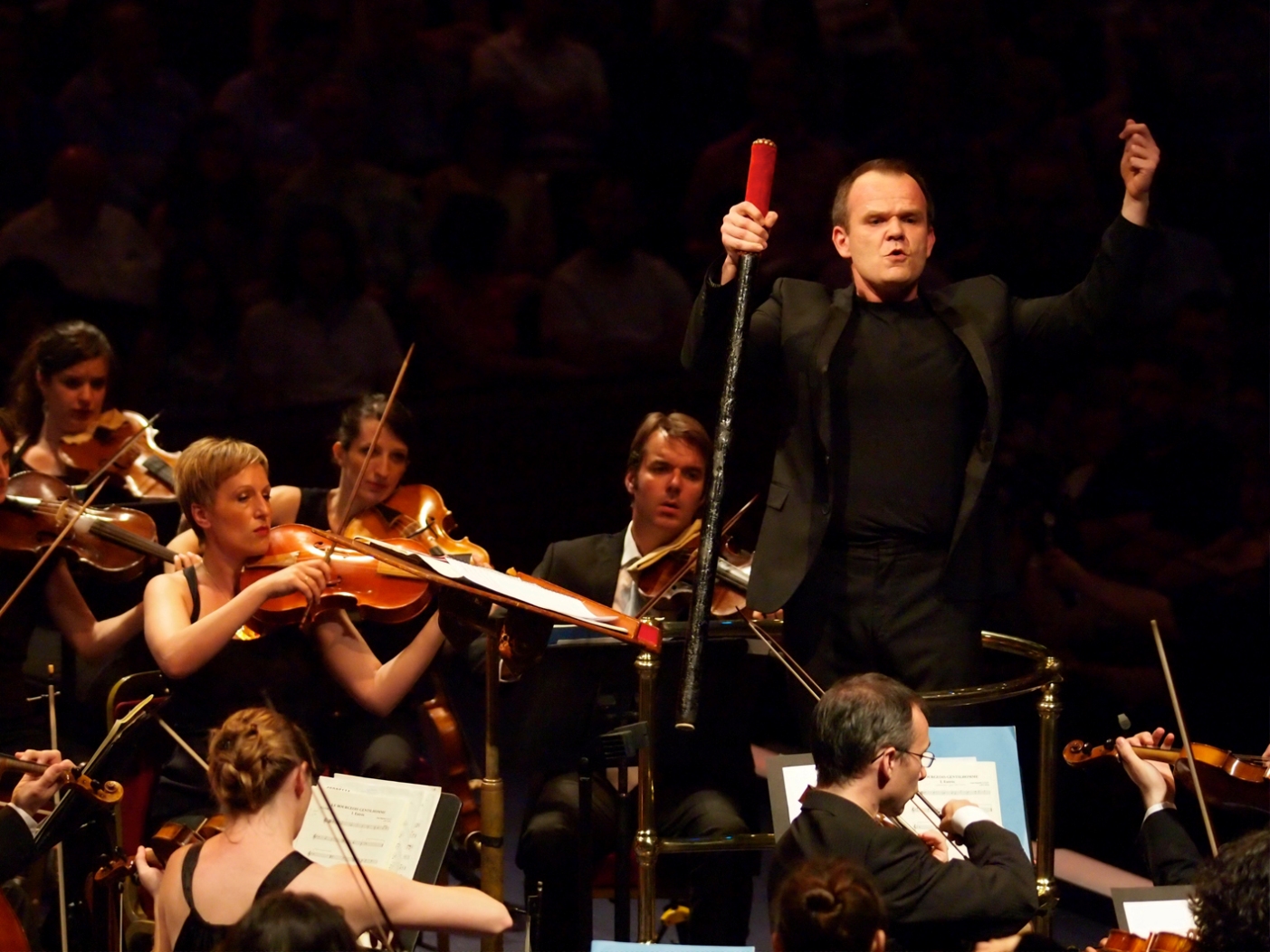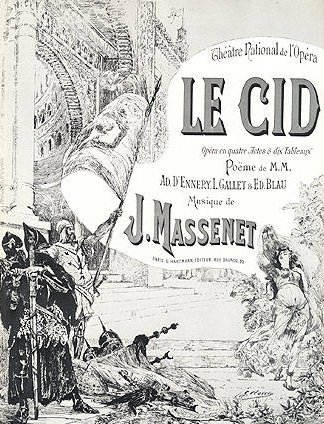Prom 4: Les Siècles, Roth | reviews, news & interviews
Prom 4: Les Siècles, Roth
Prom 4: Les Siècles, Roth
Fresh and light approach to nearly 250 years of ballet music in Paris
You can get away with playing ballet music of the Ancien Régime on Bastille Day so long as you end with a revolution. That was how live wire François-Xavier Roth and his mostly French musicians angled it, covering nearly 250 years of Parisian dance premieres on their way to the Proms centenary performance of Stravinsky’s The Rite of Spring.
There were spectacles few, if any, will have seen at the Proms. Roth beginning proceedings by striking his red-handled staff, in homage to the very pre-baton instrument which struck Lully’s toe in 1687 and killed him from a gangrenous infection (Roth pictured below last night by Sisi Burn). Shaking of a handsome bell tree or Turkish crescent during the two most exotic court dances. Fresh, post-18th century fiddles waiting on stage to take the place of the oldsters. Players turning to salute the bust of Sir Henry Wood and, more specifically, the audience seated either side of the organ.
 Yet there were also the notorious Albert Hall acoustics which flattened, sometimes killed stone dead, Roth’s attempts to bring the gut and bite of the authentic approach (why don't I trust my instincts and head straight down into the Arena, the only place where anything registers properly?). Hearing Lully and Rameau through a gauze came as a special shock only a week after I’d been overwhelmed by the ferocity of the Orchestra of the Age of Enlightenment under William Christie in Glyndebourne’s stunning Hippolyte et Aricie.
Yet there were also the notorious Albert Hall acoustics which flattened, sometimes killed stone dead, Roth’s attempts to bring the gut and bite of the authentic approach (why don't I trust my instincts and head straight down into the Arena, the only place where anything registers properly?). Hearing Lully and Rameau through a gauze came as a special shock only a week after I’d been overwhelmed by the ferocity of the Orchestra of the Age of Enlightenment under William Christie in Glyndebourne’s stunning Hippolyte et Aricie.
No matter; Lully was shaped with as much affection as his formality would allow, and it’s little wonder if Rameau came off as much the more adventurous; after all, there are 65 years between the comedy-ballet Le bourgeois gentilhomme in 1670 and Les Indes galantes in 1735 (as much time as elapsed between Strauss’s Der Rosenkavalier and Britten’s Death in Venice). Still, you wonder if Lully would ever have reached the weird harmonic descents Rameau plumbs in the middle of his Danse du grand Calumet de la paix.
Violins were exchanged, extra players brought on: midway through the first half we moved on to the 19th century and, alas, only half the originally promised quarter-hour of music from Delibes’s Coppélia. Only the whole ballet score will do next time at the Proms. As it was, we got not the Musique des Automates, the doll music which would have continued a sense of le merveilleux originating in Louis XIV’s court, but the ubiquitous waltz and mazurka, both inappropriately automatic and too fast (unless Roth knows something about Delibes’s metronome markings that I don’t).
 There was more playfulness about the Spanish divertissement from Massenet’s Le Cid (original poster for the opera pictured left), but why lop two of the seven equally inventive dances? Anyway, you couldn’t ask for more from Massenet in terms of piquant orchestration and melody. Among many woodwind colourings of pure delight, Stéphane Morvan’s cor anglais solo before the Madrilène's giddying take-off told us that Massenet got there way before Rodrigo in terms of Spanish soulfulness.
There was more playfulness about the Spanish divertissement from Massenet’s Le Cid (original poster for the opera pictured left), but why lop two of the seven equally inventive dances? Anyway, you couldn’t ask for more from Massenet in terms of piquant orchestration and melody. Among many woodwind colourings of pure delight, Stéphane Morvan’s cor anglais solo before the Madrilène's giddying take-off told us that Massenet got there way before Rodrigo in terms of Spanish soulfulness.
Perhaps it was apt in this company that the Les Siècles view of The Rite of Spring was often brisk, bright and snappy. Roth’s promise of more colours in the use of 1913-era brass certainly materialized in the incisive, garish trumpets, less so in the sometimes dodgy horn ensemble. There was no question, though, of the disgrace which the last French visitor to the Proms in this work, the Orchestre National de France under Daniele Gatti, brought upon itself with a disastrous botched entry. Roth had his own ideas about timing of attack and precision of those famous reiterated chords, and everything seemed to work as he wanted it to.
No special novelties struck us for some time after the hideous coughing obbligatos that accompanied the opening pipes; was it Stravinsky’s weaker original scoring or just the lack of string power that failed to bring out one of the many melodies in Part One? You had to wait until the Chosen One had virtually danced herself to death before subtleties struck which the composer must have thought didn’t sound well enough leading up to ultimate collapse. And that, at least, with cymbals and guero or lion’s roar adding their voices to the final chord, was something none of us would have heard before.
rating
Explore topics
Share this article
Add comment
The future of Arts Journalism
You can stop theartsdesk.com closing!
We urgently need financing to survive. Our fundraising drive has thus far raised £33,000 but we need to reach £100,000 or we will be forced to close. Please contribute here: https://gofund.me/c3f6033d
And if you can forward this information to anyone who might assist, we’d be grateful.

Subscribe to theartsdesk.com
Thank you for continuing to read our work on theartsdesk.com. For unlimited access to every article in its entirety, including our archive of more than 15,000 pieces, we're asking for £5 per month or £40 per year. We feel it's a very good deal, and hope you do too.
To take a subscription now simply click here.
And if you're looking for that extra gift for a friend or family member, why not treat them to a theartsdesk.com gift subscription?
more Classical music
 MacMillan St John Passion, Boylan, National Symphony Orchestra & Chorus, Hill, NCH Dublin review - flares around a fine Christ
Young Irish baritone pulls focus in blazing performance of a 21st century classic
MacMillan St John Passion, Boylan, National Symphony Orchestra & Chorus, Hill, NCH Dublin review - flares around a fine Christ
Young Irish baritone pulls focus in blazing performance of a 21st century classic
 Classical CDs: Romance, reforestation and a Rolleiflex
New music for choir, orchestra and string quartet, plus a tribute to a rediscovered photographer
Classical CDs: Romance, reforestation and a Rolleiflex
New music for choir, orchestra and string quartet, plus a tribute to a rediscovered photographer
 First Person: St John's College choral conductor Christopher Gray on recording 'Lament & Liberation'
A showcase for contemporary choral works appropriate to this time
First Person: St John's College choral conductor Christopher Gray on recording 'Lament & Liberation'
A showcase for contemporary choral works appropriate to this time
 Donohoe, RPO, Brabbins, Cadogan Hall review - rarely heard British piano concerto
Welcome chance to hear a Bliss rarity alongside better-known British classics
Donohoe, RPO, Brabbins, Cadogan Hall review - rarely heard British piano concerto
Welcome chance to hear a Bliss rarity alongside better-known British classics
 London Choral Sinfonia, Waldron, Smith Square Hall review - contemporary choral classics alongside an ambitious premiere
An impassioned response to the climate crisis was slightly hamstrung by its text
London Choral Sinfonia, Waldron, Smith Square Hall review - contemporary choral classics alongside an ambitious premiere
An impassioned response to the climate crisis was slightly hamstrung by its text
 Goldberg Variations, Ólafsson, Wigmore Hall review - Bach in the shadow of Beethoven
Late changes, and new dramas, from the Icelandic superstar
Goldberg Variations, Ólafsson, Wigmore Hall review - Bach in the shadow of Beethoven
Late changes, and new dramas, from the Icelandic superstar
 Mahler's Ninth, BBC Philharmonic, Gamzou, Bridgewater Hall, Manchester review - vision and intensity
A composer-conductor interprets the last completed symphony in breathtaking style
Mahler's Ninth, BBC Philharmonic, Gamzou, Bridgewater Hall, Manchester review - vision and intensity
A composer-conductor interprets the last completed symphony in breathtaking style
 St Matthew Passion, Dunedin Consort, Butt, Queen’s Hall, Edinburgh review - life, meaning and depth
Annual Scottish airing is crowned by grounded conducting and Ashley Riches’ Christ
St Matthew Passion, Dunedin Consort, Butt, Queen’s Hall, Edinburgh review - life, meaning and depth
Annual Scottish airing is crowned by grounded conducting and Ashley Riches’ Christ
 St Matthew Passion, Irish Baroque Orchestra, Whelan, St Patrick’s Cathedral, Dublin review - the heights rescaled
Helen Charlston and Nicholas Mulroy join the lineup in the best Bach anywhere
St Matthew Passion, Irish Baroque Orchestra, Whelan, St Patrick’s Cathedral, Dublin review - the heights rescaled
Helen Charlston and Nicholas Mulroy join the lineup in the best Bach anywhere
 Kraggerud, Irish Chamber Orchestra, RIAM Dublin review - stomping, dancing, magical Vivaldi plus
Norwegian violinist and composer gives a perfect programme with vivacious accomplices
Kraggerud, Irish Chamber Orchestra, RIAM Dublin review - stomping, dancing, magical Vivaldi plus
Norwegian violinist and composer gives a perfect programme with vivacious accomplices
 Small, Hallé, Wong, Bridgewater Hall, Manchester review - return to Shostakovich’s ambiguous triumphalism
Illumination from a conductor with his own signature
Small, Hallé, Wong, Bridgewater Hall, Manchester review - return to Shostakovich’s ambiguous triumphalism
Illumination from a conductor with his own signature
 LSO, Noseda, Barbican review - Half Six shake-up
Principal guest conductor is adrenalin-charged in presentation of a Prokofiev monster
LSO, Noseda, Barbican review - Half Six shake-up
Principal guest conductor is adrenalin-charged in presentation of a Prokofiev monster

Comments
I was surprised so many
I don't suppose many people
I don't suppose many people have sat through a performance of the Symphonie Funebre et Triomphale, Sebastian. But they might have caught the instrument in Rossini or Maxwell Davies. And they will probably have heard a reference to it as a 'sistrum' in Bizet's Carmen - the Danse Boheme, with its first line, rather oddly translared as 'the jingles of the sistrums tinkled'...
What I haven't seen before is a conductor using a staff like that - who has?